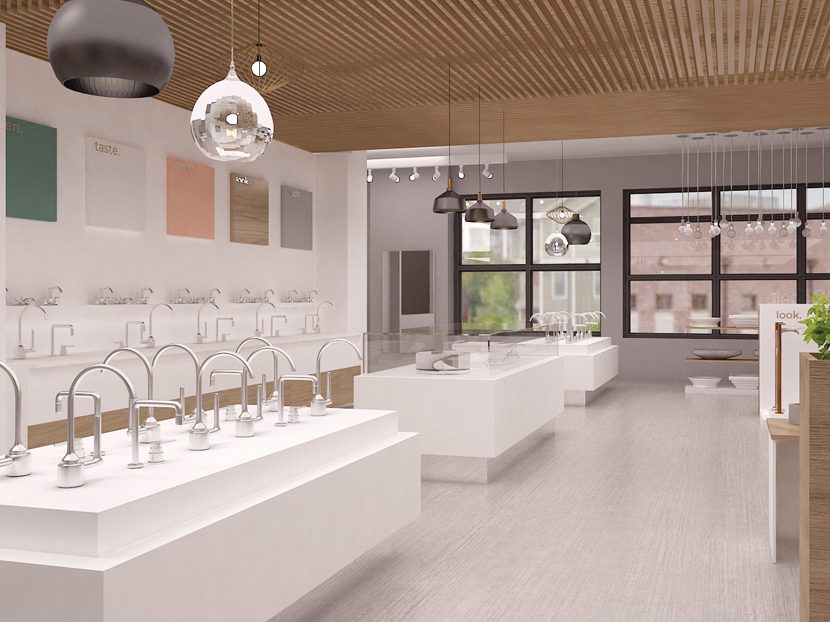Merchandising for the Future
Merchandising for the Future

A customer who walks into the showroom or looks in from the street makes a split-second decision about whether or not they will stay. It seems unfair that shoppers won’t give retail environments more of a chance, but with so many online and offline options available, people are bound to be particular about where they spend their money.
In a world where 52 percent of customers won’t return to a store if they don’t like the aesthetic, it is critical that retailers make the best first impression possible. A smart merchandising plan is an excellent place to start.
Believe it or not, the way items are displayed in a store has a significant impact on the psychological state of the buyer. You can imagine, based on whether the impact is positive or negative, what that does to sales potential.
First Impressions
The look of a showroom is crucial no matter what your target audience is. Unfortunately, aesthetics are considered after things such as product mix and pricing, often to the showroom’s disadvantage. A cardinal rule of retail is that first impressions count, and those first impressions are visual more often than not.
Our eyes control our perception of a space — 83 percent of the information our brain processes and collects comes from our sight. The next most important sense is hearing. That tells you what senses you should target to get an emotional response and, more importantly, how easy it is to put someone off with out-of-date aesthetics or loud noises, for example.
A first impression should leave a shopper with feelings of excitement, desire, nostalgia or even envy (the “keeping up with the Joneses” mindset is a powerful driver). These are strong emotions that can override a person’s regular shopping habits.
Using these emotions to your showroom’s advantage doesn’t require an advanced degree in psychology because the formula is quite simple. When people feel good, they pull out their wallets!
Remember, if the expansion of online shopping and the resulting change in physical retail has offered any lesson, it’s that experience counts more than a reasonable price. If you can get a customer through the door by making a great first impression, you’re more than halfway there.
Traditional Showroom Merchandising
As a showroom design firm, it is our job to look at an existing showroom and find ways to make it more attractive to customers, which in turn makes it more profitable for the stakeholders. The traditional merchandising philosophy suggests putting out as many items as possible, and this practice prevails even in new build-outs.
A traditional merchandising practice in kitchen and bath showrooms goes back to the days when these items were sold in warehouse or wholesale environments. In these situations, the tactic was to put out as many products as possible and hope for the best. Thankfully, we’ve moved past that point and showroom merchandising has evolved to take into account many different types of consumers.
Current design practices in retail result in airy, toned-down spaces a customer can truly feel comfortable in. There is no reason why a showroom can’t do the same! Our clients ask for designs that pack in as much product as possible. We counter with a suggestion to strip it all back.
Create a Vista with Horizontal Merchandising
A showroom has options when it comes to greeting customers. It can confront shoppers with a variety of merchandise from the moment they walk in, or it can implement horizontal merchandising and uninterrupted lines of sight to invite shoppers to enter.
Both options have their risks and benefits, and each tells a different brand story. The first says, “We have everything you need.” This can be overwhelming for some shoppers and as we have suggested, the place for huge variety is now online.
A wide-open view of the showroom tells a different story: “Come in and explore.” It allows clients to take a breath upon entering, to be greeted by salespeople and keeps product at hand-level.
Keeping products at a lower level creates comfort on several levels. It eliminates the stress of being overwhelmed by options. It establishes excellent lines of sight, especially from the entrance of the showroom. It allows a client to walk in, take a breath and scan the entire store.
Move merchandise-heavy displays to the walls or even incorporate the store-within-a-store technique. Vignettes can be kept near windows to capture the effects of natural light and to draw in window shoppers. Instead of using accessory towers and vignettes or other tall displays to guide the client through the store, vertical merchandising techniques can be kept to the walls around the edges of the showroom.
Real-Life Touch Points
A horizontal merchandising technique keeps items at hand-level and allows for attractive cross-merchandising opportunities. Hand-level product placement is ideal in a kitchen and bath showroom setting, as customers want to touch and try the merchandise.
That is why people are still shopping in physical stores. You can’t touch products you see on a screen; 50 percent of shoppers say they don’t like only shopping online for that very reason. Placing items such as sinks at hand-level makes it easier to imagine them in context. No one is putting their new bathroom sink in the wall.
Touching an object also makes people more likely to buy it. Encouraging this interaction contributes to the endowment effect, which suggests people place a higher value on the things they own, and touching an item helps them feel a sense of ownership.
A Less-Is-More Showroom Is Possible
Having a less-is-more showroom is possible when you are realistic about your competition — and we’re not talking about other kitchen and bath showrooms. The biggest competitor in the industry is the great big world of e-commerce.
Fortunately, you are not Amazon and you don’t have to be. Yes, great prices can attract customers, as can variety. But isn’t that what online shopping is all about? Chances are you have an online business component that you use to the advantage of your bottom line. Let the online do what it does best (great prices and options) and consider what you can do in the physical showroom to shatter customer expectations.
Keep price and variety in mind but focus on the strengths of physical retail to compliment online offerings you have.
What can you do in the showroom if price and variety are not the ways you will draw customers in? In 2019, physical retail has to focus on building long-term relationships with clients via exemplary customer service and the look of the physical space. These are the strengths of brick-and-mortar spaces; this is where customers come into contact with the elements that matter.





